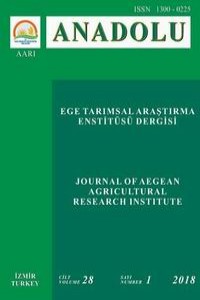Abstract
ÖZ: Mersin bitkisi (Myrtus
communis L.), Akdeniz ikliminin karakteristik bir meyvesidir. İri ve beyaz
renkli meyveye sahip olan ve ‘Hambeles’ adıyla bilinen mersinlerin uzun
yıllardır yetiştiriciliği bölgede yapılmaktadır. Siyah renkli mersinler ise
doğada yabani olarak yetişmekte ve daha küçük meyvelidir. Siyah mersinde
şimdiye kadar ülkemizde tescil edilmiş bir çeşit yoktur. Antalya yöresinde
yapılan gözlemler sonucu nispeten iri meyveli tipler tespit edilmiştir. Bu
çalışmanın amacı, farklı iki ekolojide yetiştirilen siyah mersin tiplerinin,
meyve verimi ve sürgün gelişimiyle ilgili özellikleri incelemektir. Mersinler
yayla ve sahil olmak üzere farklı iki ekolojide yetiştirilmiştir. Bitkiler yayla
koşullarında yabani bitkiler üzerine kültür tiplerinin yama aşı metoduyla
aşılanmasıyla tesis edilmiştir. Sahil koşullarında ise bitkiler çelikten
yetiştirilmiştir. Yama aşılardan çıkan sürgün sayısı 3.9-7.0 arasında
değişmiştir. Bu sürgünler ikinci yıl 208 cm kadar boy yapmışlardır. Üçüncü
yılki sürgün uzunluğu ise en fazla 104 cm olmuştur. Meyve verimi üçüncü yıldan
itibaren belirgin bir şekilde artmış ve 10.6 kg/bitki ye kadar yükselmiştir.
References
- Narinc, D., and A. Aygun. 2017. A Non Parametric Data Transformation Technique for Quantitative Genetic Analyses: The Rank Transformation. International Conference on Advances in Natural and Applied Sciences, AIP Conference Proceedings, 1833, DOI: 10.1063/1.4981708.
- Mulas M., and M. R. Cani. 1999. Germplasm evaluation of spontaneous myrtle (Myrtus communis L.) for cultivar selection and crop development. J. Herbs Spices and Medical Plants 6 (3): 31-49.
- Mulas, M., A. H. D. Francesconi, and B. Perinu. 2002a. Myrtle (Myrtus communis L.) as a New Aromatic Crop: Cultivar Selection, Journal of Herbs Spices & Medicinal Plants 9 (2-3): 127-131.
- Mulas, M., A. H. D. Francesconi, B. Perinu, and A. Fadda. 2002b. ‘Barbara’ and ‘Daniela’: Two cultivars for Myrtle Berries production. Acta Hortuculturae 576: 169-175.
- Surmaghi, M. H. S., G. Amin, A. Shakibafar, and B. Azadi. 2014. Unexpected volatile compounds of Myrtus communis L. fruit rind growing in Iran. Int. J. Biol. And Pharm. Research 5 (5): 428-431.
- Uzun, H. İ., U. Aksoy, and Ş. Gözlekci. 2014. Endüstriyel amaçlı organik siyah mersin yetiştiriciliğinin geliştirilmesi. TAGEM-10/ARGE-02 nolu proje sonuç raporu.
Abstract
ABSTRACT: Myrtle (Myrtus
communis L.), is a characteristic plant of Mediterranean climate. The
myrtle plant, known as ‘Hambeles’, which has a white and large fruit had been
cultivated in the region for many years. The black myrtle plant on the other hand,
grows wild in forest characterized by smaller fruit sizes. Up to now, there has
not been any registered black myrtle variety in our country. The results of the
observations made in Antalya province showed the presence of some black myrtle
ecotypes with large fruits. The aim of this study was to examine the
characteristics of black myrtle types; fruit yield and shoot growth performance
of this plant grown in two different ecologies of Antalya province. The myrtle
plant has been cultivated in two different ecological areas, such as high and
low lands. The cultured types were budded on the wild plants under high land
conditions by using the patch budding method, whereas under low land
conditions, the plants were grown by using own-rooted cuttings. The number of
shoots emerged from the patches ranged from 3.9 to 7.0. The shoot length
increased up to 208 cm in second growing season, but decreased to 104 cm in the
third year. Fruit yield has increased markedly from the third year and reached
up to 10.6 kg / plant.
References
- Narinc, D., and A. Aygun. 2017. A Non Parametric Data Transformation Technique for Quantitative Genetic Analyses: The Rank Transformation. International Conference on Advances in Natural and Applied Sciences, AIP Conference Proceedings, 1833, DOI: 10.1063/1.4981708.
- Mulas M., and M. R. Cani. 1999. Germplasm evaluation of spontaneous myrtle (Myrtus communis L.) for cultivar selection and crop development. J. Herbs Spices and Medical Plants 6 (3): 31-49.
- Mulas, M., A. H. D. Francesconi, and B. Perinu. 2002a. Myrtle (Myrtus communis L.) as a New Aromatic Crop: Cultivar Selection, Journal of Herbs Spices & Medicinal Plants 9 (2-3): 127-131.
- Mulas, M., A. H. D. Francesconi, B. Perinu, and A. Fadda. 2002b. ‘Barbara’ and ‘Daniela’: Two cultivars for Myrtle Berries production. Acta Hortuculturae 576: 169-175.
- Surmaghi, M. H. S., G. Amin, A. Shakibafar, and B. Azadi. 2014. Unexpected volatile compounds of Myrtus communis L. fruit rind growing in Iran. Int. J. Biol. And Pharm. Research 5 (5): 428-431.
- Uzun, H. İ., U. Aksoy, and Ş. Gözlekci. 2014. Endüstriyel amaçlı organik siyah mersin yetiştiriciliğinin geliştirilmesi. TAGEM-10/ARGE-02 nolu proje sonuç raporu.
Details
| Primary Language | English |
|---|---|
| Journal Section | Makaleler |
| Authors | |
| Publication Date | May 15, 2018 |
| Submission Date | April 20, 2017 |
| Published in Issue | Year 2018 Volume: 28 Issue: 1 |


